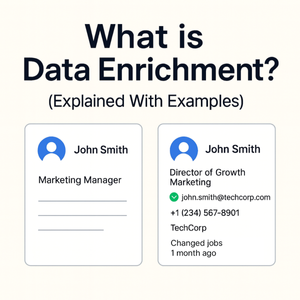Most link building campaigns don’t fail because of weak content or bad timing — they fail because of bad prospecting. If your contact list is messy, irrelevant, or misaligned, your outreach is doomed from the start. Bounced emails, poor response rates, and damaged sender reputation are all symptoms of the same root issue: poor prospect data.
Think about it — every email you send to the wrong person isn’t just wasted effort, it’s a hit to your domain’s deliverability. Every time you pitch the wrong editor or scrape contacts too broadly, you burn trust, credits, and time. You can’t afford for your “engine room” of link building to be running on broken parts.
The answer is to elevate your prospecting process. By combining smart domain qualification, carefully targeting the right contacts, and using tools like Findymail, you can create a clean, efficient pipeline of opportunities. In this guide, I’ll show you exactly how to build, clean, and export prospect lists that fuel - not frustrate- your link building efforts.
Role of Findymail in Link Building
Findymail isn’t a magic wand - it’s a contact data engine. Used right, it gives you clean, verified contacts at scale.
The specific link building tactics where it can shine:
- Guest posting campaigns where you need editors and content managers.
- Link insertions that rely on finding content authors or site owners.
- PR outreach and thought leadership where you need journalists, editors or a specific sector editor.
- Resource page outreach targeting administrators, or very specific profiles at non-profits or public institutions.
Where it will probably fall short: reactive PR opportunities (like HARO or Featured) where journalists hand you their details anyway. You probably won’t need Findymail here, but for every other tactic, it is a very important tool to have in your arsenal.
Findymails bulk email finder option has a cool feature where you can search for certain roles within a list of domains. - enabling you to find, for instance, all the Head of Marketing people, at each website.
Use Findymail as the “fuel injection system” for your strategy — it makes a good engine run smoother but it can’t drive the car by itself.
The major advantage of using Findymail over many of the traditional email finders, is that it has a much more enhanced validation technology behind the platform, and can even determine if many catch-all status emails are valid. The end result is that you tend to be able to capture 20-30% more emails when using Findymail, over other providers.
Step 1: Building a High-Quality Prospect List
Every great outreach campaign starts with great inputs. If your domain list is weak, even the best contact data won’t save you.
As we outline in The Links Guy’s link building checklist, prospecting isn’t just a “step”; it’s the strategic spine of your campaign. Get it right, and everything downstream becomes easier.
Here’s a framework you can use to get it right:
- Pre-qualify domains: Use traffic or domain authority metric filters using Ahrefs or Semrush and relevance checks (using smart use of AI + human checks), to weed out weak or low quality prospects before you even start collecting contacts.
- Source lists smartly: Pull from SERP scraping, tools like Ahrefs’ Content Explorer, SE Ranking SERP checker, or backlink exports from competitors, to source relevant websites or webpages.
- Batch by tactic: A guest post prospect list isn’t the same as a PR list. Keep them separate - blending contexts can make personalization or the outreach template segmentation less effective.
Example: If you’re targeting a topic like “SEO tips for law firms” you don’t want every site that’s ever mentioned SEO. Instead, you would ideally want relevant publishers with an audience overlap - think marketing blogs, legal industry editorials, and other associations and organizations related to the legal industry.
Step 2: Pulling Contacts in Bulk (Findymail in Action)
Now that you’ve got domains, it’s time to put Findymail to work.
- How it works: Findymail searches multiple data sources, then verifies emails against mail servers to minimize bounces.
- Enrichment: Pulls LinkedIn data, job titles, and company details so you’re not just blasting random inboxes.
- Bulk scraping tips: Don’t hit “extract all.” Filter smartly. Pulling every contact from every domain burns credits and lands you in the wrong inboxes.
- Granularity matters: For mid-tier campaigns, pulling a few content-related roles at scale is fine. For high-value PR or journalist outreach, you’ll want to handpick category editors or writers.
If you are able to work with Findymai’s API, you can go even more granular with your contact finding, and make a script to find very specific employees at that list of domains.
Pro tip from our own campaigns: Always spot-check batches manually before sending. The last thing you want is to be reaching out to the CEO of medium to large sized businesses - when the marketing or content manager would be a better fit.
The few minutes you spend here can prevent you from burning through mismatched lists. More on this next.
Step 3: Matching Outreach Type to the Right Contact
Here’s where most prospecting falls apart: sending the right pitch to the wrong person.
Drawing from our own experience doing link building since 2015, and what the internal data shows:
- Guest Posting: Target content managers, strategists, blog managers, or editors. (Note: SaaS companies are a slight anomaly, as often the CMO or Founder can be involved in writing content, due to the lean nature of the teams.)
- Resource Pages: If it's a public institution like a library or university, you may need to look for administrators, outreach managers, or for some, it will be very specific coordinators. This person may be listed on the page itself, or within their “staff” directory.
- PR/Thought Leadership: Journalists, editors, or section-specific media leads.
- Link Insertions: Content writers, site owners, or founders - and yes, for a small or a local business, often a generic inbox will be the only remaining option.
Nuances to remember:
- Small blogs → often founders/owners are fine as there will only be 1-2 people working on the blog anyway.
- Large companies → stick to mid-level editors, not global directors. “Global” or “Content Director” level roles should often be avoided for these large businesses, as they are too high up in the hierarchy and oversee a large team
- News/editorial sites → avoid tier 1 publications unless you’re pitching product/category editors directly. Journalists at tier 1 media publications will rarely insert a link in an already existing article (unless there is a very compelling reason).
LinkedIn Sales Navigator can be a handy way of downloading a targeted list of prospects. Just filter by job title (e.g., Content Manager) if that’s pertinent to your link building tactic and import that into Findymail.
While you won’t always be able to be 100% accurate with your job title targeting - it's important to understand how to get the majority of it correct, and ensure you can steer campaigns in the right direction. Emailing the wrong titles too often is more than wasted effort. It tanks response rates and, worse, can hurt deliverability if your messages get marked as spam.
Step 4: Vetting & Cleaning the Contact List
Not all “valid” emails are useful. A verified email for an intern isn’t going to help you land a guest post.
Your vetting checklist:
- Strip irrelevant roles: Remove interns, freelancers, or off-topic titles.
- Filter domains: Cut junk sites, and PBNs from your outreach. You will probably cut out the majority of them when you do the SEO metric filtering in Step 1, but you may want to enhance this with some more advanced filtering - using AI to identify “link farms” or using metrics like Outbound to Inbound link ratio or Trust Ratio (from MajesticSEO.)
- Catch-all vs. valid: Handle with care. Catch-alls can inflate your “valid” count but still bounce. However, with Findymail’s email validation technology, it can validate many catch-all emails as well. This is especially important with websites like university sites, government or medium to large sized businesses - many of them are using Outlook, and therefore by default, their mail server is a catch-all server.
Here’s where email deliverability best practices come in. A dirty list leads to:
- High bounce rates → ISPs mark you as risky if you have too many bounces within a short span of time.
- Low engagement → inbox placement suffers if you have low replies.
- Damaged reputation → harder to recover your email domain health and you risk burning that domain.
Think of list cleaning as a health check for your email reputation. Clean data doesn’t just improve your outreach — it protects your sender domain for future campaigns.
Step 5: Exporting & Outreach Integration
With a clean list in hand, now it’s time to plug it into your outreach system.
- Export from Findymail into tools like Pitchbox, Instantly, or SmartLead.
- Clean personalization tags: Make sure names, company fields, and job titles are properly formatted and you use the personalization tags correctly. Nothing kills credibility faster than “Hi [FirstName].”
- Segment campaigns by type: Don’t mix guest post asks with PR pitches. Each requires its own sequence and personalization layer. Findymail has some great link building outreach templates here, you can adapt to your campaigns.
Exactly how it looks, depends on the link building tactic being used and industry you’re dealing with - but here’s an example of one of our outreach templates. The idea here being we kept the email industry-relevant, and pitched an idea we knew could resonate.
As we covered in our outreach guide, the quickest way to tank efficiency is to blend multiple tasks into one messy campaign or have badly targeted email campaigns.
Common Pitfalls with Findymail Prospecting
- Scraping too broadly: Pulling every contact from a site instead of filtering for relevance.
- Misaligning contacts: Pitching a CEO for a guest post = in some (but not all cases) wasted time.
- Ignoring site type: Approaching a B2B SaaS company like a personal blog. The SaaS company may respond better to you offering to do a link exchange or doing some other cross-promotion. While someone blogging about their hobby, will respond well to personalization or editorial value.
- Over-relying on volume: Whether you power it with AI, or still retain some manual input - personalization trumps spray-and-pray every time (here’s one reply we got from a large wedding portal who responded to our outreach email)
Final Thoughts: Findymail as a Force Multiplier
Findymail won’t hand you a strategy - but it will supercharge a good one.
If you want to consistently land backlink placements, think of link prospecting as more than just pulling emails. It’s about aligning strategy with execution: pre-qualifying strong domains, choosing the contacts most likely to respond, and protecting your deliverability with clean data. When those pieces are in place, Findymail acts as a force multiplier, allowing you to scale your outreach without sacrificing quality.
In short, the winning formula is strategy first, tools second. Master the fundamentals of prospecting, then let Findymail do what it does best — help you turn precision targeting into real, scalable link building results.





